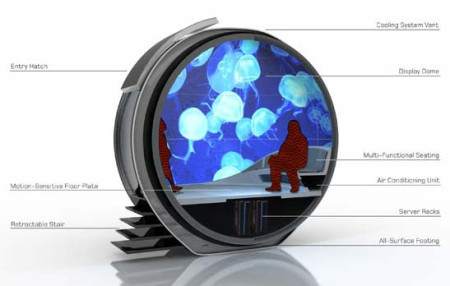London (England) – At a major science event in London today called Pioneer 09, a new device under development called a Virtual Cocoon has been showcased. The kitchen-sized device encases the user in a sensory input room which virtual reality headsets alone cannot achieve. The potential level of virtual reality the device will deliver has caused the research team to coin a new phrase: Real Virtuality.
Not just a virtual reality device, the ability to stimulate all five senses with a reported high degree of realism makes the real virtuality experience possible, though it requires some expensive hardware.
Scientists from the Universities of York and Warwick, with funding from the Engineering and Physical Sciences Research Council (EPSRC) have brought together what they believe is the expertise necessary to extend their existing Towards Real Virtuality project even further, making it a completely real experience to fool even the most die-hard skeptic.
The team hopes to provide a real experience “in which all senses are stimulated in such a way that the user has a fully immersive perceptual experience, during which s/he cannot tell whether or not it is real.”
As part of that effort, the team has constructed a mock-up of a multi-million dollar virtual reality cage, of sorts, which completely surrounds the individual.

Called a Virtual Cocoon, the round-room device provides a far more realistic delivery of virtual experiences via total sensory input. This device positions the occupant in a chair before a nearly 360 degree screen where s/he becomes completely immersed in not only a visual and audio presentation encompassing almost the full view, but also one where the occupant has skin sensations, smells and tastes.
It will be a highly specialized device with some amazing electronics and compute abilities, including its own server-room which is situated just beneath the floor. A mock-up of the device is on display today at Pioneers 09, which is an EPSRC showcase event held at London’s Olympia Conference Centre.
A University of York professor, David Howard, who is lead scientist on the project, said, “Virtual Reality projects have typically only focused on one or two of the five senses – usually sight and hearing. We’re not aware of any other research group anywhere else in the world doing what we plan to do. Smell will be generated electronically via a new technique being pioneered by Alan Chalmers and his team at Warwick which will deliver a pre-determined smell recipe on-demand. Taste and smell are closely linked but we intend to provide a texture sensation relating to something being in the mouth. Tactile devices will provide touch.”
The team is working on enhancing the interaction of the five senses, so that they mimic real life more closely. No one sense should be over- or under-stimulated, and while this device is impressive the scientists acknowledge there is much room for improvement.
Some legal concerns are also being debated right now, such as the meaning of a Real Virtuality world, which is separate from the real world, and yet fully immersive to the individuals involved. What health, safety and even ethical considerations are there? The answer to these types of questions have different meanings for different individuals, and will likely someday become a real consideration in public law.






